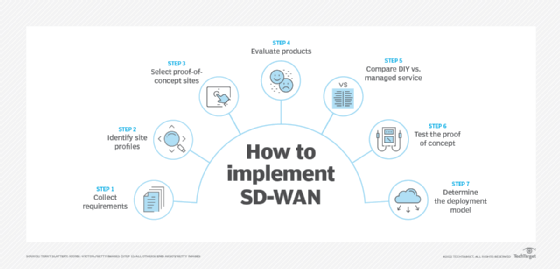
Getty Images
7 steps of an SD-WAN implementation
Organizations interested in implementing SD-WAN need to collect site profiles and requirements, analyze their options, perform tests and evaluate the results.
The benefits of software-defined WAN make many organizations interested in adopting it, but the implementation process can seem daunting.
Enterprises can use this seven-step process as a guide to deploy a successful SD-WAN implementation.
Step 1. Collect requirements
Collecting requirements is always the first step to implement an SD-WAN architecture.
Enterprises often cite cost reduction over MPLS WANs as an important requirement, but SD-WAN doesn't always result in a significant cost benefit. Instead, network teams should look to improve network resilience against outages or tighten network security for a work-from-anywhere workforce.
Other benefits include a more agile business due to centralized management or a reduction in operations and maintenance tasks that free staff to work on strategic initiatives.
Step 2. Identify site profiles
Use the functional requirements specification to identify connectivity requirements, application traffic flows, quality of service (QoS), quality of experience, bandwidth and security. Then, identify a small number of different site types within the network. Minimizing the number of different site types increases consistency across the network, resulting in improved automation, faster troubleshooting and a reduction in configuration complexity.
Teams can sort sites into categories that include the following:
- offices with video conferencing and SaaS connectivity;
- manufacturing facilities;
- warehouses;
- engineering design facilities or healthcare radiology centers, characterized by large files, high bandwidth and custom apps; and
- corporate data centers that host proprietary applications.
Each site's profile determines the functional requirements for factors like link bandwidth, failover circuits, QoS, security and monitoring.
Step 3. Select proof-of-concept sites
Identify proof-of-concept (POC) sites. Select a few of the most important site types for the POC. Once those are identified, the next step is to determine the circuit characteristics of the sites to order the corresponding test circuits. The lead time for procuring circuits is normally long, so teams should place circuit orders for the sites as soon as they know which links to order.
Thoroughly evaluate carrier architectures, as some providers heavily oversubscribe their network infrastructure, resulting in a higher level of packet loss. Note that even small levels of packet loss can cause a significant reduction in application performance. Incorporate a packet loss measurement and an independent measurement mechanism in the service-level agreements with the carriers.

Step 4. Evaluate products
Begin the paper evaluation of potential products, referring to industry resources for potential vendors, and begin assembling selection criteria. The market changes quickly, with new product features releasing periodically. Competition is fierce, but expect that features are comparable across vendors, with some proprietary variations. Functions like Secure Access Service Edge are becoming commonplace.
Keep in mind that protocols used for SD-WANs are proprietary and don't enable interoperability between products from different vendors.
Step 5. Compare DIY vs. managed service
Next, determine the types of available offerings: DIY, co-managed with a managed service provider or fully outsourced to an MSP. The selection depends on the resources teams can muster for the evaluation and implementation. For example, a global enterprise may find it useful to partner with an MSP who has established relationships with ISPs in foreign countries.
Finding an MSP that is familiar with providing SD-WAN could tip the scales in its favor because of its ability to bring experienced people, processes and technology to the table. These resources could streamline the evaluation and SD-WAN implementation, making it worth the expense.
Step 6. Test the proof of concept
Begin hands-on evaluation with the POC in the lab. This step can happen while waiting for circuits and can cover as many products as necessary, although network teams should likely limit it to the top two or three candidates. Be sure to evaluate performance using traffic generators and monitoring functions.
Do the policy mechanisms provide the functionality needed? How easy is the zero-touch provisioning (ZTP) deployment? Do the traffic handling policies work for the traffic mix? How does the SD-WAN interface work with nonconverted sites? What visibility does the monitoring system provide? Do the security measures work? Create failure scenarios, and evaluate the network management alerting and troubleshooting mechanisms.
It might be tempting to create partial or sample policies for testing purposes, but that could end up costing more than it's worth. It's best to focus on the thought process of identifying all elements of the production policies so that teams understand the product, its limitations, its capabilities and whether it achieves its goals.
It's possible to work with the products in this step without affecting production applications, so be as thorough as possible. Take advantage of the product's automation systems to run the evaluation tests. Also, if possible, create tests to use on the production network. This is where an experienced SD-WAN MSP can be beneficial. The output of this step should be the identification of a potential awardee.
Step 7. Determine the SD-WAN model
Determine the appropriate deployment model. Vendors either offer preferred models or provide choices to customers. Is hardware required at each site, or does it use a virtual implementation that requires a VM host? Does ZTP enable shipment directly to each site, or does it need staging somewhere? How can teams verify circuits before turning them over to production?
Use the deployment model to extend the POC from the lab to a low-risk production site. If that is successful, deploy to other POC sites as success continues.
This step validates the implementation and the deployment model in the production environment. It should result in few surprises, other than perhaps finding a forgotten application or two. Include at least one of each type of critical production site in this step to verify that the product satisfies the most stringent requirements.
Finalize the selection
This is the end of the evaluation process. These steps might feel painstaking, but thoroughness of the approach makes the transition to production implementation go much smoother.








